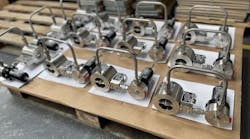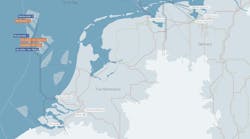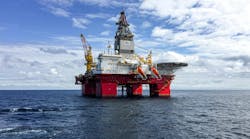High pressure water mist systems are being used to safeguard platforms in the Far East and North Sea against fire damage. The technique, developed by Fogtec (Germany), involves dousing a wide area with minimal amounts of water by means of special nozzles.
The systems employ pure water, which is atomized at 100 bar into 0.01 mm diameter droplets. A reaction surface area of 200 sq meters can be reached using a liter of water. That compares with the 2 sq meters typically achieved by sprinkler systems with 1 mm droplets. This larger reaction surface in turn aids absorption of the fire's combustion energy. Furthermore, the much lower volumes of water employed, allied to the faster evaporation rate of the mist generated, lessen the potential for secondary structural damage.
Fogtec recently began supplying the offshore sector, including Esso/Petronas platforms offshore Malaysia, where the systems were installed to replace halon-based equipment in 71 gas turbine enclosures, and for BP's Harding platform in the UK North Sea.
Replacing halon
According to Fogtec's Managing Director Dirk Sprakel, halon systems remained the firefighting medium of choice for many years, because they were reliable. Their small, compact size was also advantageous on offshore installations where space is always at a premium. Now, however, any systems incorporating chemical gases or cleaning agents are at a disadvantage. Halon-based systems will be banned in Europe from 2003 under new Euro-pean Union legislation.
Pure water is non-noxious, hence the interest in water-mist systems. However, there remain only two major players in the market - Marioff in Finland and Fogtec. As a division of German pump manufacturer Kamat-Pumpen, Fogtec was using high pressure water as a tool for cutting through metal and concrete and for stressing overland pipelines in Russia. Working at pressures over 100 bar was common. The technology was first introduced by the Lechler group in Stuttgart in the 1930s. Fogtec refined the technique in association with Lechler and various German/European research establishments, including Sintef in Norway and the Rostock-based marine safety institute, ISV. Fogtec runs its own test facility, located near Munster.
How it works
Once the mist droplets have diffused across the reaction surface, their subsequent absorption of the fire's energy leads to an immediate drop in temperature of the ambient air or gases. This in turn protects equipment in the vicinity from radiant heat. Swift conversion of the droplets into steam leads to further energy absorption.
Vaporization increases the water volume more than 1,600 times. Air/oxygen locally is displaced, thereby suppressing the flames, but the oxygen concentration away from the fire is virtually undisturbed. This lessens the risk to any staff that may be present. Gas extinguishing systems cannot achieve the same effect, according to a Fogtec engineer. If the oxygen content is already low, Fogtec is said to work faster.
"With gas systems, you have to decrease the oxygen content to 12% to extinguish the fire. But our system works with oxygen content of 16-17%, and this only in the direct vicinity of the fire," Sprakel commented. "In turbine rooms, therefore, you can afford some exchange of air, which makes it safer for firefighters to enter." The mist droplets also trap or dissolve flue gas particles, lessening the resultant flue gas damage. Furthermore, use of water instead of gas as an extinguishing agent aids visibility for staff trying to make a quick exit.
The main components of the high-pressure water mist system are a unit for pressure generation, piping, and nozzles. Each system is tailored according to the level of protection/risk involved, in terms of the nozzle type, droplet size distribution, flow rate, and discharge period. Typically, in offshore applications, 100 bar pressure provides sufficient energy to disperse the water in optimum size droplets. This level of pressure also reduces the quantity of water needed to suppress the fire.
Different shapes of nozzles are provided for ceilings, raised floors, computer rooms and offshore turbines. Within the nozzle bodies are micro-nozzles, designed to make the water rotate extremely quickly. Plunger pumps or cylinder systems are used to achieve the appropriate water speed. All Fogtec systems for offshore applications are designed to operate a group of nozzles simultaneously, like a deluge system.
"When the spinning water leaves the nozzle orifice," Sprakel says, "it splits automatically. That sounds simple, but you must have a defined droplet system and flow rate for every application. That can only be achieved by devising fire tests for each application."
Turbine applications
For gas turbines, water mist brings real benefits. There are two aims to fulfill:
- Putting out the fire as soon as possible (because turbines are expensive and critical to operations)
- Cooling down the outside of the turbine very smoothly. If this were done in an un-engineered way, it would create cracks on the turbine's surface. This action is easier and uses very smooth water mist than the heavier droplets generated by lower pressure sprinkler systems, according to Fogtec.
In hazardous area equipment rooms, open nozzles are normally employed, integrated into a dry pipe deluge system. These nozzles are activated simultaneously when an alarm signal is received from a separate detection system. For accommodation areas, the operation is more on the lines of a conventional sprinkler system. Here, the nozzle enclosure incorporates a frangible bulb designed to activate independently, allowing localized protection and fire/ smoke suppression.
When the nozzle head is activated by a fire's heat, the system pressure climbs automatically to 100 bar, leading to diffusion of the water mist. Simultaneously, a signal is relayed to the control panel on the bridge. Release of water mist continues until the situation is under control, at which point the pump can be turned off manually. The smaller droplets require less water to generate than traditional low-pressure sprinkler systems. This allows lighter, small-bore pipework to be adopted (10-40 mm diameter).
In 2000, Fogtec conducted comprehensive tests for local protection and for machinery spaces, respectively to secure IMO approval to IMO 930 and IMO MSC668. These tests were witnessed by representatives from Lloyds and DNV. ABS, RINA and NKK in Japan have also observed tests. Fogtec has passed factory mutual fire and component tests for 270 cu meters gas turbine enclosures. Other potential applications suited to high pressure water mist systems offshore include power, compression, control, and accommodation modules on production platforms and public/engine spaces on floating production, storage, and offloading vessles, drilling rigs, and supply vessels.




